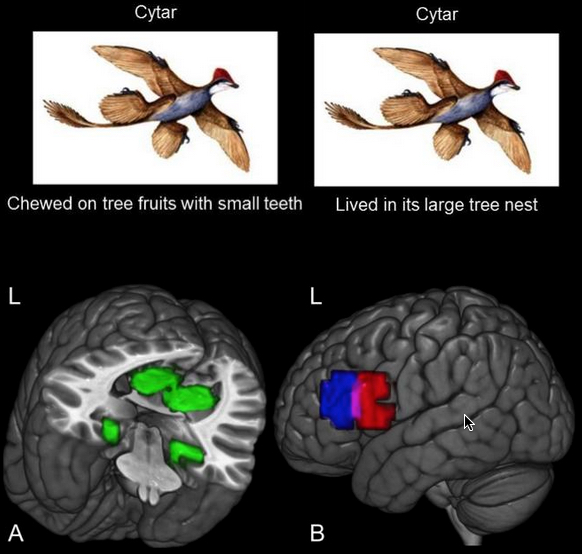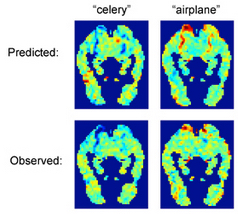First glimpse of new concepts developing in the brain
June 12, 2015

This image illustrates how the study participants learned about the habitat and the diet of eight animals, such as the cytar (not its real zoological name) and shows the set of habitat brain regions (A-green) and diet (B-red and blue) regions where the new knowledge was stored. (L refers to left hemisphere of the brain.) (credit: Carnegie Mellon University)
Carnegie Mellon University (CMU) scientists have for the first time documented the actual formation of newly learned concepts inside the brain.

Predicting the unique brain activation patterns associated with names (credit: CMU)
Thanks to recent advances in brain imaging technology at CMU and elsewhere, it is now known how specific concrete objects are coded in the brain — neuroscientists can identify which object, such as a house or a banana, someone is thinking about from its functional magnetic resonance imaging (fMRI) brain signature.
Taking the next step, the researchers decided to observe the actual formation of these signatures in an experiment.
Neuroscientist Marcel Just, the D.O. Hebb University Professor of Cognitive Neuroscience in CMU’s Dietrich College of Humanities and Social Sciences, and Andrew Bauer, a Ph.D. student in psychology, taught 16 study participants diet and dwelling information about extinct animals to monitor the growth of the neural representations of eight new animal concepts in the participants’ brains.
Drawing on the previous research findings, the research team knew “where” to expect the new knowledge to emerge in the brains of their participants. Information about dwellings and information about eating have each been shown to reside in their own set of brain regions, regions that are common across people.
Over the course of an hour, the study participants were given a zoology mini-tutorial on the diets and habitats of the animals, while the scientists used fMRI to monitor the emergence of the concepts in the participants’ brains. As the new properties were taught, the activation levels in the eating regions and the dwelling regions changed.
Concept signatures
One important result was that after the zoology tutorial, each one of the eight animal concepts developed its own unique activation signature. This made it possible for a computer program to determine which of the eight animals a participant was thinking about at a given time. In effect, the program was reading their minds as they contemplated a brand-new thought.
Even though the animals had unique activation signatures, the animals that shared similar properties (such as a similar habitat) had similar activation signatures. That is, a resemblance between the properties of two animals resulted in a resemblance between their activation signatures. This finding shows that the activation signatures are not just arbitrary patterns, but are meaningful and interpretable.
“The activation signature of a concept is a composite of the different types of knowledge of the concept that a person has stored, and each type of knowledge is stored in its own characteristic set of regions,” Just said.
Another important result was that once a property of an animal was learned, it remained intact in the brain, even after other properties of the animal had been learned. This finding indicates the relative neural durability of what we learn.
Implications for learning and brain disorders
“Each time we learn something, we permanently change our brains in a systematic way,” said Bauer, the study’s lead author. “It was exciting to see our study successfully implant the information about extinct animals into the expected locations in the brain’s filing system.”
Just believes that the study provides a foundation for brain researchers to trace how a new concept makes its way into the brain from the words and graphics used to teach it. That suggests that it may be possible to assess the progress in learning a complicated concept like those in a high-school physics lesson. fMRI pattern analyses could diagnose which aspects of a concept students misunderstand (or lack), in a way that could guide the next iteration of instruction.
The results from this study also indicate that it may be possible to use a similar approach to understand the “loss” of knowledge in various brain disorders, such as dementia or Alzheimer’s disease, or due to brain injuries. The loss of a concept in the brain may be the reverse of the process that the study observed.
Abstract of Monitoring the growth of the neural representations of new animal concepts
Although enormous progress has recently been made in identifying the neural representations of individual object concepts, relatively little is known about the growth of a neural knowledge representation as a novel object concept is being learned. In this fMRI study, the growth of the neural representations of eight individual extinct animal concepts was monitored as participants learned two features of each animal, namely its habitat (i.e., a natural dwelling or scene) and its diet or eating habits. Dwelling/scene information and diet/eating-related information have each been shown to activate their own characteristic brain regions. Several converging methods were used here to capture the emergence of the neural representation of a new animal feature within these characteristic, a priori-specified brain regions. These methods include statistically reliable identification (classification) of the eight newly acquired multivoxel patterns, analysis of the neural representational similarity among the newly learned animal concepts, and conventional GLM assessments of the activation in the critical regions. Moreover, the representation of a recently learned feature showed some durability, remaining intact after another feature had been learned. This study provides a foundation for brain research to trace how a new concept makes its way from the words and graphics used to teach it, to a neural representation of that concept in a learner’s brain.